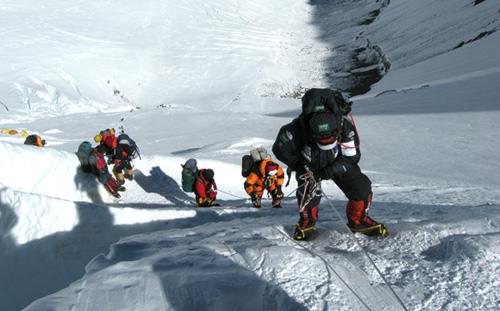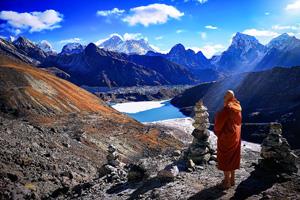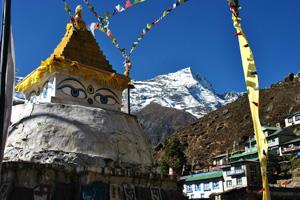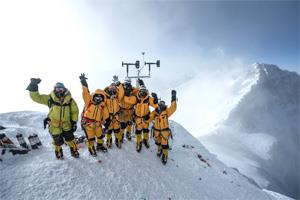
Little more than a year ago, American mountain climber Don Cash died on Mt. Everest just hours after he had reached the summit.
Cash wasn't the first to die on Everest, and he won't be the last. What made Cash's death unique was that he was one of 200 people who climbed to the top of the world that day, and he was caught in a traffic jam on his way down. As Outside magazine later reported, when Cash and his Sherpa guides reached the Hillary Step, they had to wait their turn to the summit for more than two hours. The weather at that altitude is volatile and treacherous, and storms can sweep in a matter of minutes. A photo taken at the time by climber Nirmal Purja, showing a "conga line" of climbers, waiting their turn at 28,800 feet, went viral.
Why do it? Why go halfway around the world to climb the world's highest mountain, only to stand in line for hours at a time, as if lining up for groceries at the local supermarket in the middle of a pandemic.
 The astounding beauty of the landscape, for one. That's one of the first things that jumps out in two engaging, eye-filling documentaries that premiere Tuesday on National Geographic Channel, Lost on Everest (9 p.m. ET), and Expedition Everest (10 p.m. ET).
The astounding beauty of the landscape, for one. That's one of the first things that jumps out in two engaging, eye-filling documentaries that premiere Tuesday on National Geographic Channel, Lost on Everest (9 p.m. ET), and Expedition Everest (10 p.m. ET).
Of the two, Expedition Everest is probably the more compelling, but they both have much to recommend.
Lost on Everest focuses on the mystery of Everest pioneer Andrew "Sandy" Irvine, George Mallory's climbing partner, who disappeared in 1924.
The second, very different, Expedition Everest, is the more topical and contemporary of the two. It follows a team of present-day climate scientists as they mount an expedition to install the world's highest weather station. "What makes one good day turn into someone else's bad day within 24 hours?" lead climber Pete Athans, a survivor of the tragic 1996 Into Thin Air expedition on Everest, asks early in the program. It's not an idle question.
Eight people died on the mountain that day in 1996, and accurate weather measurement at that altitude has taken on added urgency as more and more climbers, many of them neophytes and first-timers, take on Everest each climbing season.
Whether you've spent weeks battling cabin fever during COVID lockdown, or you're dealing with the heat and humidity of an early summer outdoors, the dark blue-black skies and white snows of Everest are a welcome sight — the NatGeo documentaries are crisp and sharp as a tack. Superlatives about drones and HD 4K camera technology are old news by now, but watching these programs really is like being there.
China/Tibet and Nepal both cancelled the brief climbing season on Everest — a tight, weeks-long window in May — this year, owing to the COVID-19 pandemic.
And while it may be hard to find too much sympathy for well-to-do high-altitude climbing tourists who think nothing of a mountaineering expedition halfway around the world, the effect on the local economies in Nepal and Tibet, where local families living on the margins rely on the annual climbing season to help clothe and feed themselves and their children year-round, has been devastating.
 This is where these two programs are especially meaningful. They're about real, flesh-and-blood people, past and present, who tested themselves against the elements long before climbing Everest became a fad for the well-to-do. National Geographic is not a travel channel. Its focus is news and information. There's something truly amazing and awe-inspiring about accompanying climate scientists from the safety of home as the scientists crunch their way through ice and snow to tackle one of the defining issues of our times. It's entirely conceivable that whatever happens in our home towns during the climate crisis will be first spotted and identified at high altitude, just as climate science in the polar regions has taken on an added urgency in recent years.
This is where these two programs are especially meaningful. They're about real, flesh-and-blood people, past and present, who tested themselves against the elements long before climbing Everest became a fad for the well-to-do. National Geographic is not a travel channel. Its focus is news and information. There's something truly amazing and awe-inspiring about accompanying climate scientists from the safety of home as the scientists crunch their way through ice and snow to tackle one of the defining issues of our times. It's entirely conceivable that whatever happens in our home towns during the climate crisis will be first spotted and identified at high altitude, just as climate science in the polar regions has taken on an added urgency in recent years.
TV documentaries are a dime-a-dozen these days, and many weigh in on the low end of the scale — low budget and made on the fly. Leave it to National Geographic, then, when holding a lens to the world's most famous and arguably awe-inspiring mountain to create two programs of real quality.
"The definition of adventure for me is the endeavor where the outcome is totally unknown," climber and writer Mark Synnot says at the outset of Lost on Everest — and outcomes don't get much more unknown than taking on the world's highest mountain in 1924, when Gore-Tex, HD television cameras, and GPS satellite technology were the stuff of science fiction.
Climbing legend George Mallory's story became clearer when his body was found on May 1, 1999 — except for one tantalizing question. Did he perish on his way down the mountain, after reaching the summit, or did he perish while making the final push? If the former, that would make Mallory the first known person to have reached the pinnacle of Chomolungma, Goddess Mother of the World.
"We are getting our first proper view of Mt. Everest," a near speechless expeditioner says early in Lost on Everest, "and it is absolutely off-the-hook spectacular, awe-inspiring, more than a little intimidating."
Moments later, the climbers' attitudes have changed.
"I know I'm not dying," one says, deadpan. "Because I desire coffee so badly."
Lost on Everest is about wonder, mystery, the human urge to explore, and the will to survive. Expedition Everest is more about science and answering the existential questions that face humanity in the near, not-too-distant future.
 Expedition Everest holds its lens against the geology of the Himalaya region and explains how the world's tallest mountain region generates river water for some of the most populated nations and regions on the planet. If the glacial ice melts on the Himalayan mountains, entire areas face drought and likely starvation. This is powerful, bracing stuff, and poses some of the most existential questions facing humankind today.
Expedition Everest holds its lens against the geology of the Himalaya region and explains how the world's tallest mountain region generates river water for some of the most populated nations and regions on the planet. If the glacial ice melts on the Himalayan mountains, entire areas face drought and likely starvation. This is powerful, bracing stuff, and poses some of the most existential questions facing humankind today.
"The simplicity of life becomes much more forward," a veteran climber says, early in Expedition Everest.
Climate science at high altitude, he says, is "the new Terra incognita… We just don't know."
As National Geographic points out in this fascinating, at-times enthralling program, we may be about to find out.